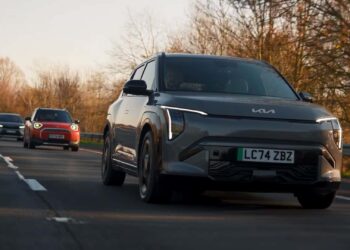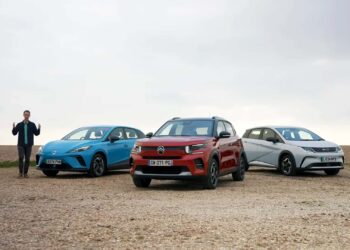Scout has finally unveiled its electric SUV and pickup, the Traveler and the Terra, and many people have been saying they look like Rivian trucks seen through a retro filter or like a mix between a Rivian and a Ford Bronco. While there is some truth to that, at least visually, they’re also quite different trucks in terms of size, scope and philosophy.
When the Scout Traveler enters the market in 2027, it will face direct competition from the Rivian R1S. It’s worth noting that the Traveler shown at the official unveiling is just the production-intent model (officially designated a concept by the manufacturer), which is about 85% finished.
Some things can still change in the three years before it enters production. The R1S, on the other hand, has been around for a few years and recently underwent a major overhaul for the 2025 model year.
Size


While the Traveler and R1S may look very similar at first glance, they actually have quite different proportions. The Scout is the longer of the two overall, with a total length of 207.9 inches versus the Rivian’s 200.8 inches, but it sits on a slightly shorter 120.4-inch wheelbase. This means that even though the R1S is shorter, it has more space between its axles, which should give it a roomier interior.
The Traveler is considerably wider than the R1S, measuring 91.6 inches without mirrors. The R1S is almost 10 inches narrower with its mirrors folded, measuring 82 inches in width. To put that into context, the Traveler is even wider than the GMC Hummer EV SUV or the Ford Bronco Raptor, which measure 86.5 inches and 86.9 inches in width, respectively.
The Scout is lower than the Rivian (76.3 inches versus 77.3 inches), and it also has less ground clearance (12.1 inches versus 14.9 inches). This is presumably for the standard steel spring suspension setup. The manufacturer hasn’t said anything about how much its ride height will vary with the available adjustable air suspension.
Power


You can get the Rivian R1S with between 533 and 665 horsepower in dual-motor configurations, 850 hp in the tri-motor, and the upcoming quad-motor variant will have 1,025 hp. The lowest-power model can sprint to 60 mph from a standstill in 4.5 seconds, which drops to 3.4–3.5 seconds in the 665-hp Dual Motor Performance model. The tri-motor R1S dips below the 3-second mark and the quad-motor will do the sprint in about 2.5 seconds.
Scout hasn’t mentioned specific power outputs for the Traveler, but all versions will come with a dual-motor all-wheel drive configuration. The manufacturer did say we should expect torque levels up to nearly 1,000 pound-feet, and the quickest version will be able to accelerate to 60 mph in 3.5 seconds.
Range


The heavily revised Rivian R1S features new battery packs with usable capacities ranging between 92.5 and 141.5 kilowatt-hours. They deliver EPA ranges of between 270 and 410 miles, making the R1S one of the longest-range SUVs available today. Because it has a 400-volt electrical architecture, it can only charge at up to 220 kW, but that’s still pretty quick, and Rivian says you should expect the 10 to 80% charge to happen in between 30 and 40 minutes, depending on the battery pack size.
Thanks to its 800-volt body-on-frame platform (specially developed for the two upcoming Scout models), the Traveler will have a higher maximum charging power of 350 kW. 350 is also the maximum number of miles that the Traveler will be able to drive on one charge. Scout hasn’t made any claims about the 10 to 80% charge time, but it should be around the 20-25 minutes mark thanks to its higher charging power.
Scout buyers will be able to specify an optional range extender (a combustion engine that will act as a generator to replenish range on the move), which will boost the figure to 500 miles. The Ram 1500 Ramcharger extended-range pickup will be powered by a similar system, but it will have a smaller battery than the fully electric Ram 1500, whereas the Scout EREV’s battery will be the same size.
Scout has confirmed that the Traveler will come equipped with a NACS charger, so it will be natively compatible with the Tesla Supercharger network. If you want to charge a Rivian R1S on a Tesla charger, you will need a CCS-to-NACS adapter to make it happen. Both vehicles support bidirectional charging.
Towing


Scout says the Traveler will have a maximum payload of almost 2,000 pounds, although it didn’t provide a final number, which is comparable to the R1S’ 1,764-pound rating. When it comes to towing, the Rivian has the advantage with a rating of 7,700 pounds, or 700 pounds more than the Scout.
Features


The Rivian R1S is a three-row SUV, so it can carry more passengers than the strictly two-row Scout Traveler. It also has a built-in air compressor that is very handy for pumping up the tires after you let some air out to improve off-road traction. Rivians are also known to be very good to drive on tarmac too, and with their standard air suspension in its lowest and stiffest setting, they actually corner at higher speeds than you would expect.
The Scout Traveler seems like a more off-road-focused vehicle. It will feature sway bar disconnects (like a Jeep Wrangler or Ford Bronco), which allow for greater wheel articulation off-road and will help prevent the car from teetering on two wheels when going over a crest at an angle. The Scout will also feature front and rear mechanical differential lockers like the proper off-road SUV that it aims to be.
Another cool Scout feature, which is also a retro touch, is the bench seat in the front. This used to be a staple of older American trucks, but it’s not something you see often in today’s models. Having three people in the front will make for a very unique experience, and given the extra width that it has over rivals, shoulder room shouldn’t be an issue.
We’re very happy Scout won’t force users to go through the touchscreen to access various functions. Most will have dedicated physical switches conveniently arranged in a row beneath the central display. It will also feature an optional Cabana Top, which is a retractable canvas roof that, once open, will give limitless headroom to both rows of seats.
Price


Scout will adopt a direct sales model similar to Tesla. This means you won’t be able to order a Scout vehicle through a regular Volkswagen dealership. The company wants to control the buying experience directly, and it will also provide maintenance and repairs in its own dedicated service centers.
Like Tesla and Lucid (and now Scout), Rivian also employs a direct sales model bypassing the traditional dealer network model and selling vehicles directly to customers.
You will be able to buy a Scout Traveler, with the current federal tax credit included, for around $50,000, which is in the same ballpark as gas-burning rivals like the Wrangler or Bronco. Although the price tag is slightly higher than the $40,000 Scout initially mentioned, it still makes these vehicles highly affordable for their size.
The range-extender powertrain will add a few thousand dollars to the price tag, but it is unlikely to make the Traveller a $60,000 vehicle.
Rivian wants $77,000 for a base R1S, which also qualifies for the $3,750 federal tax credit. If the vehicle’s value exceeds $80,000, which it will if you want any of the more potent, longer-range versions, then you won’t be able to claim the tax credit. The current top variant, the R1S TriMax, starts at $105,900, and the future range-topping quad-motor will likely cost more than $120,000.






